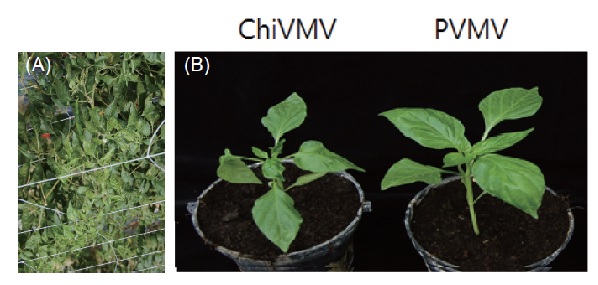All issues

Author:Ying-Huey Cheng*, Chin-Chih Chen, Jau-Yeuh Wang, Chia-Dian Chiang, and Chin-An Chang
Abstract:
Pepper crops are commonly infected with two potyviruses, chilli veinal mottle virus (ChiVMV) and pepper veinal mottle virus (PVMV) in Taiwan. ChiVMV and PVMV share the highest sequence
similarity of coat protein genes among potyviruses, preventing serological differentiation between the two viruses. However, the nucleotide sequences between the N-terminal region of the coat protein and the 3' non-coding region (3'-NTR) of two viruses are significantly different from each other. Based on 3'-NTR sequence divergence, ChiVMV and PVMV can be molecularly differentiated by designed primers in reverse transcriptase-polymerase chain reaction (RT-PCR). For serological detection, the ChiVMV-specific antiserum was prepared using a fusion protein as an antigen. The antigen consisted of the divergent and most proximal N-terminal 39 amino acids (4.3 kDa) of ChiVMV coat protein as hapten and green fluorescent protein (28.2 kDa) as a carrier. Both heptan and carrier peptides were constructed into bacterial expression vector pET-28b (+) to produce an expressed fusion protein of 32.5 kDa in Escherichia coli Rosetta. The fusion protein was then immunized rabbits at regular intervals, and the harvested antiserum was used for enzyme-linked immunosorbent assay (ELISA) or Western blotting to detect ChiVMV. The antiserum reacted positively and specifically to ChiVMV, but neither to PVMV nor non-inoculated plants. The ChiVAM-specific antiserum could specifically detect ChiVMV from field-collected samples, even in the presence of PVMV. When compared with the preparation of monoclonal antibodies, using the bacterial express fusion proteins containing ChiVMV partial coat protein to prepare polyclonal antisera is quicker, easier, and more economic.
Key words:Chilli veinal mottle virus (ChiVMV), Expression protein, Polyclonal antibody
Download:![]() PDF Links
PDF Links
- 1. Development of Tractor-Mounted Seedling Transplanter for Sweet Potato
- 2. Synergistic Effect of Additional Gas on the Toxicity of Phosphine to Sitophilus oryzae and Sitophilus zeamais (Coleoptera: Dryophthoridae)
- 3. Effects of Temperature and Solar Radiation on Growth Traits and Plant Elements in Purple Leafy Sweet Potato
 Submit your manuscript
Submit your manuscript
 Guide for authors
Guide for authors